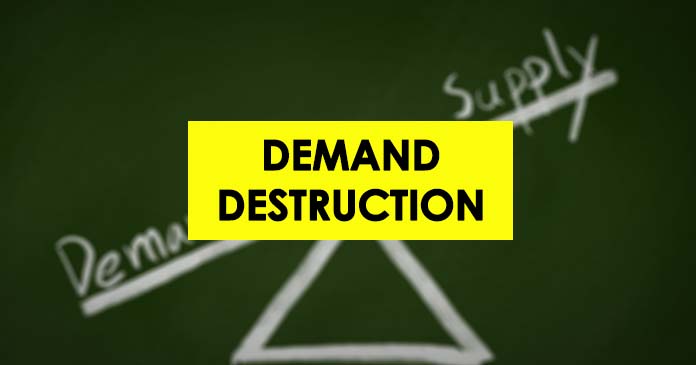Demand destruction is the term used to describe a decline in consumer demand for a good or service, usually caused by political, environmental, technological, or economic issues. Demand destruction can have serious effects on businesses and economies. It might result in a decline in revenue and earnings, job losses and layoffs, a decrease in consumer spending, and a decline in economic expansion.
Causes of Demand Destruction

Economic recessions: Consumers may reduce their spending due to decreased income or economic uncertainty, which can result in demand destruction. This can lead to a drop in demand for goods and services, which can harm businesses and economies.
Technological disruption: The arrival of newer, more effective goods or services may cause older, less effective alternatives to lose market share. This might happen when new technologies make particular goods or services outdated or present customers with a more attractive alternative.
Environmental factors: Natural disasters and climate change can interrupt manufacturing, supply chains, and consumer demand, causing demand destruction. For example, a natural disaster can harm infrastructure. It would lower production and lower demand for particular goods or services.
Political factors: Trade restrictions and policies can reduce demand by changing the availability and price of goods and services. For example, taxes or import limitations may increase the price or decrease the availability of particular goods or services, reducing demand.
Impact of demand destruction on businesses and economies
Demand destruction can have severe effects on economies and businesses, including
- Decrease in sales and profits
- Layoffs and job losses
- Decrease in consumer spending
- Decrease in economic growth
Businesses and governments must understand the implications of demand destruction to establish management and mitigation solutions.
| Impact | Description |
|---|---|
| Decrease in sales and profits | A drop in demand for a product or service can lead to a decline in sales, leading to a decrease in profits. This can have significant business consequences, such as layoffs and job losses. |
| Layoffs and job losses | Businesses may be forced to fire employees or lower their staff to minimize expenses due to a decline in sales and profits caused by demand destruction. This can also result in job losses and raise the unemployment rate. |
| Decrease in consumer spending | Demand destruction can also lead to decreased consumer spending because consumers may lower their spending due to economic uncertainty or the availability of replacements for the product or service. This may also result in a drop in business profits and sales. |
| Decrease in economic growth | Demand destruction can have broader economic effects as it could slow down economic growth. This can be caused by a decline in consumer spending, business activity, and employment, which can all contribute to a decrease in economic growth. |
Strategies for managing demand destruction
Businesses and governments can use various strategies to control and reduce the effects of demand destruction.
- Diversification of product or service offerings
- Cost cutting measures
- Innovation and technology adoption
- Collaboration and partnerships
Diversification of product or service offerings
A business can decrease its reliance on any one particular product or service that may be subject to demand destruction by diversifying its products or services. This can help to distribute risk and improve business resilience.
Cost cutting measures
Businesses may need to cut costs in order to stay profitable during periods of demand destruction. This may include taking steps like making cuts to resource usage, streamlining operations, or hiring fewer people.
Innovation and technology adoption
Businesses can keep demand for their goods and services by using new technologies, creating new products, or both. This can involve implementing new production techniques, new marketing plans, or launching brand-new goods or services.
Collaboration and partnerships
Businesses that link up or collaborate with other businesses can access new markets and customers, share resources and risks, and save costs. This can help companies in remaining competitive and maintaining demand for their products or services during times of demand destruction.
Conclusion
The destruction of demand is a complicated and dynamic phenomenon that can have significant consequences for economies and businesses. Businesses and governments may contribute to maintaining and encouraging economic growth and stability by recognizing the causes of demand destruction and putting into place efficient measures to manage and reduce its impacts.
Frequently Asked Questions (FAQs)
Is demand destruction permanent?
The permanence of demand destruction depends on the underlying causes and the ability of businesses and governments to adapt to changing market conditions. In some cases, it may be temporary, while in other cases it may be more permanent. Understanding the causes of demand destruction and implementing strategies to manage and mitigate its impact can help businesses and governments to adapt to changing market conditions and protect economic growth and stability.
Why is demand destruction bad?
Demand destruction can be damaging to the economy as it may result in lower consumer spending, job losses, layoffs, and sales and profits. Understanding and managing the impact of demand destruction is essential for reducing its effects and promoting economic stability since these unfavorable effects can have a major effect on businesses and countries.
Does inflation lead to demand destruction?
Particularly in the energy markets, high costs can lead to demand destruction. However, only if it encourages consumers to change their behaviors in a long-term manner.
When there is inflation, prices tend to rise across the board in all areas of the economy. As a result, rising gas prices may also result in rising expenses for housing, food, and automobiles. In this scenario, demand destruction is less likely because all alternatives increase in price simultaneously.


